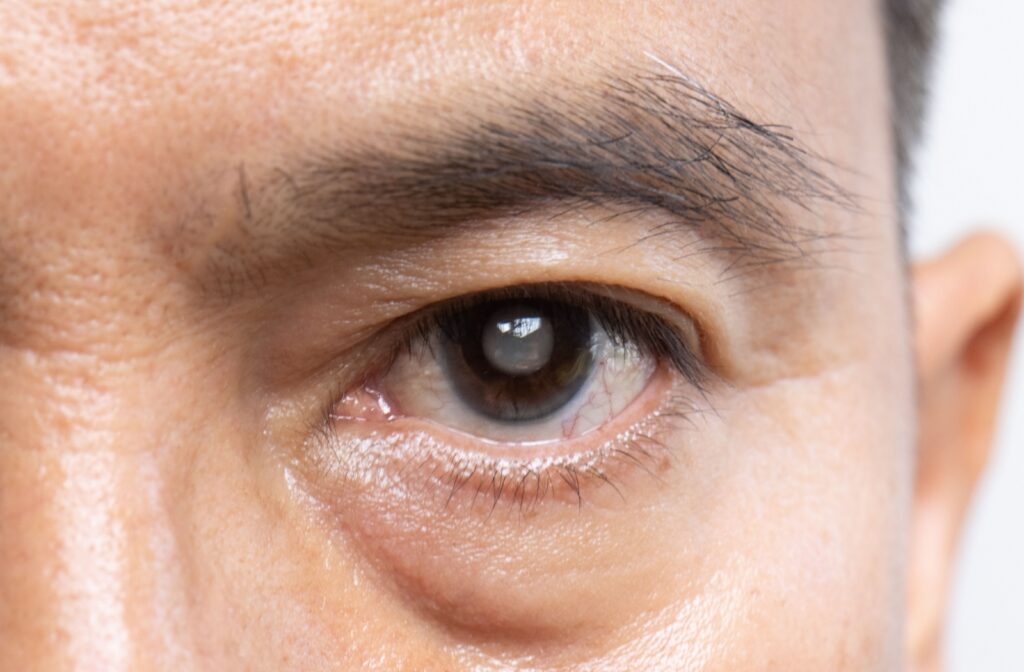Cataracts are a common vision concern, especially for adults over 40. It can be easy to blame cataracts when vision changes cause discomfort or pain behind your eye. Unfortunately, the answer may be a bit more complex.
Cataracts themselves do not cause pain behind the eye. However, they can lead to secondary issues that might result in discomfort. If you’re ever in doubt about the source of your symptoms, your optometrist is ready to help with eye exams and effective treatments.
What Are Cataracts?
Cataracts occur when your eye’s natural lens becomes cloudy, reducing its ability to focus light effectively. This is a natural part of aging, though it can be worse for certain people. It happens because, over time, proteins in the lens start to clump together, leading to a gradual loss of clarity in your vision.
Think of your eye’s lens like a camera lens—clear and essential for focusing on objects. When a cataract forms, it’s almost as though a foggy film is covering that lens, distorting the image your brain processes. This process is generally painless but can significantly affect your ability to see.
Common Symptoms of Cataracts
Cataract symptoms usually develop slowly and worsen over time. Here are some signs to watch for:
- Cloudy or blurry vision
- Difficulty seeing in low light
- Sensitivity to bright light and glare
- Halos around lights
- Frequent prescription changes
- Faded or dull colors
- Double vision in one eye
As you may notice, while these symptoms can be bothersome, cataracts themselves don’t directly cause pain.
This is because cataracts form in the lens, which does not contain pain receptors. The clouding and thickening of the lens happen painlessly, even as your vision deteriorates. The changes are so gradual, so you might not notice them at first. Any discomfort often comes indirectly from the impact these vision changes have on your daily life.
Secondary Issues Related to Cataracts
While cataracts don’t directly result in pain behind the eye, they can lead to conditions that may cause discomfort:
- Eye strain and headaches: Poor or blurry vision can force your eyes to work harder to focus, leading to eye strain and tension headaches. For example, glare from lights or difficulty reading small fonts on a screen may create unnecessary strain.
- Risk of falls or injuries: Compromised vision increases your chances of tripping, bumping into objects, or falling. These incidents can result in injuries that could lead to ongoing discomfort or physical pain.
- Discomfort from glare: Bright lights and glare may make you squint or strain your eyes.
While these related issues can be frustrating, they’re not a direct result of cataracts but rather complications arising from impaired vision, and you could also link them to untreated myopia or nearsightedness. If your eyes hurt, there may be another cause.

Conditions That Could Cause Pain Behind the Eye
Several conditions may cause pain behind your eye, ranging from mild strain to more serious underlying issues. Common causes include:
- Digital eye strain: Prolonged use of digital screens can lead to discomfort behind the eyes, often accompanied by dryness, redness, and fatigue. This is also known as computer vision syndrome.
- Sinus pressure or infection: Sinusitis or infections in the sinus cavities can cause significant pressure and pain around or behind the eyes, often linked to nasal congestion or headaches.
- Optic neuritis: This condition involves inflammation and swelling of the optic nerve and can result in sharp pain, especially when moving the eye. Optic neuritis may also cause vision changes and requires prompt medical attention.
- Migraines or cluster headaches: Eye pain is a frequent symptom of severe headaches, such as migraines or cluster headaches. Such pain is often intense and localized around one eye.
- Glaucoma: A sudden increase in intraocular (inside the eye) pressure, as seen in acute glaucoma, can produce severe eye pain and vision problems. Glaucoma is a serious condition that can cause vision loss if not correctly treated.
If you experience persistent or severe pain behind the eye, vision changes, or any related symptoms like redness, swelling, or nausea, it’s important to consult your optometrist promptly. Early evaluation can identify underlying issues and help prevent potential complications.
Remember, regular eye exams are key to maintaining overall eye health and addressing concerns before they become more serious.
Clear Vision Means Clearer Days Ahead
Cataracts may not cause direct pain, but they can lead to frustrating and sometimes dangerous complications. Managing cataracts early can help you enjoy your daily life without vision problems holding you back. If you’re already living with cataracts and start to notice eye pain, don’t ignore it. Your cataracts likely aren’t the cause and prompt treatment is essential.
If you’re dealing with vision changes, we’re here to help. Book an appointment at Dr. Goldstone Vision Center today. Our compassionate team knows what it takes to manage cataracts and can look deeper to discover what’s causing your eye pain, offering personalized solutions to help you see your world more clearly.
Your vision deserves professional care, and we’re here to provide it!



